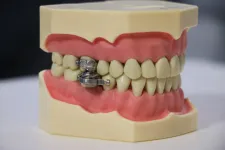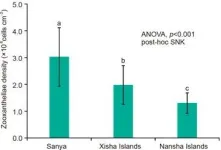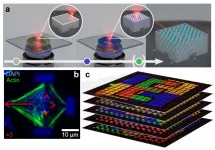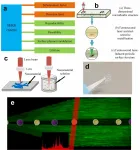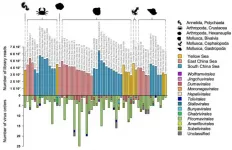Honey, we shrunk the intense XUV laser
2021-06-28
(Press-News.org) The invention of the laser has opened the era of nonlinear optics, which today plays an important role in many scientific, industrial and medical applications. These applications all benefit from the availability of compact lasers in the visible range of the electromagnetic spectrum. The situation is different at XUV wavelengths, where very large facilities (so called free-electron lasers) have been built to generate intense XUV pulses. One example of these is FLASH in Hamburg that extends over several hundred meters. Smaller intense XUV sources based on HHG have also been developed. However, these sources still have a footprint of tens of meters, and have so far only been demonstrated at a few universities and research institutes worldwide.
A team of researchers from the Max Born Institute (Berlin, Germany), ELI-ALPS (Szeged, Hungary) and INCDTIM (Cluj-Napoca, Romania) has recently developed a new scheme for the generation of intense XUV pulses. Their concept is based on HHG, which relies on focusing a near-infrared (NIR) laser pulse into a gas target. As a result, very short light bursts with frequencies that are harmonics of the NIR driving laser are emitted, which thereby are typically in the XUV region. To be able to obtain intense XUV pulses, it is important to generate as much XUV light as possible. This is typically achieved by generating a very large focus of the NIR driving laser, which requires a large laboratory.
Scientists from the Max Born Institute have demonstrated that it is possible to shrink an intense XUV laser by using a setup which extends over a length of only two meters. To be able to do so, they used the following trick: Instead of generating XUV light at the focus of the NIR driving laser, they placed a very dense jet of atoms relatively far away from the NIR laser focus, as shown in Fig. 1. This has two important advantages: (1) Since the NIR beam at the position of the jet is large, many XUV photons are generated. (2) The generated XUV beam is large and has a large divergence, and can therefore be focused to a small spot size. The large number of XUV photons in combination with the small XUV spot size makes it possible to generate intense XUV laser pulses. These results were confirmed by computer simulations that were carried out by a team of researchers from ELI-ALPS and INCDTIM.
To demonstrate that the generated XUV pulses are very intense, the scientists studied multi-photon ionization of argon atoms. They were able to multiply ionize these atoms, leading to ion charge states of Ar2+ and Ar3+. This requires the absorption of at least two and four XUV photons, respectively. In spite of the small footprint of this intense XUV source, the obtained XUV intensity of 2 x 1014 W/cm2 exceeds that of many already existing intense XUV sources.
The new concept can be implemented in many laboratories worldwide, and various areas of research may benefit. This includes attosecond-pump attosecond-probe spectroscopy, which has so far been extremely difficult to do. The new compact intense XUV laser could overcome the stability limitations that exist within this technique, and could be used to observe electron dynamics on extremely short timescales. Another area that is expected to benefit is the imaging of nanoscale objects such as bio-molecules. This could improve the possibilities for making movies in the nano-cosmos on femtosecond or even attosecond timescales.
INFORMATION:
[Attachments] See images for this press release:

ELSE PRESS RELEASES FROM THIS DATE:
2021-06-28
A naturally occurring peptide in sunflower seeds was synthetically optimised and has now been identified as a potential drug for treating abdominal pain or inflammation (in the gastrointestinal tract, abdominal area and/or internal organs). That is the finding of an international study led by Christian Gruber from MedUni Vienna's Institute of Pharmacology (Center for Physiology and Pharmacology), which was conducted jointly with the University of Queensland and Flinders University in Australia and has now been published.
The scientific aim of the study is to find analgesics that are only active in the periphery and do not cross the blood-brain barrier, as an alternative to commonly used synthetic opioids. Gruber explains the background: "Morphine was one of the first ...
2021-06-28
In a new scientific investigation headed by the German Leibniz Institute for Zoo and Wildlife Research (Leibniz-IZW), water from African and Mongolian waterholes as well as bloodmeals from Southeast Asian leeches were assessed for the ability to retrieve mammalian viruses without the need to find and catch the mammals. The scientists analysed the samples using high throughput sequencing to identify known viruses as well as viruses new to science. Both approaches proved to be suitable tools for pandemic prevention research as they allow finding and monitoring reservoirs of wildlife viruses. For example, a novel coronavirus most likely associated with Southeast Asian deer species was identified. The results are ...
2021-06-28
An international research team led by HKUST has developed a simple but robust blood test from Chinese patient data for early detection and screening of Alzheimer's disease (AD) for the first time, with an accuracy level of over 96%.
Currently, doctors mainly rely on cognitive tests to diagnose a person with AD. Besides clinical assessment, brain imaging and lumbar puncture are the two most commonly used medical procedures to detect changes in the brain caused by AD. However, these methods are expensive, invasive, and frequently unavailable in many countries.
Now, a team led by Prof. Nancy IP, Vice-President for Research and Development at HKUST, has identified 19 out of the 429 plasma proteins associated with AD to form ...
2021-06-28
University of Otago, New Zealand, and UK researchers have developed a world-first weight-loss device to help fight the global obesity epidemic.
DentalSlim Diet Control is an intra-oral device fitted by a dental professional to the upper and lower back teeth. It uses magnetic devices with unique custom-manufactured locking bolts. It allows the wearer to open their mouths only about 2mm, restricting them to a liquid diet, but it allows free speech and doesn't restrict breathing.
Participants in a Dunedin-based trial lost an average of 6.36kg in two weeks and were motivated to continue with their weight loss ...
2021-06-28
Coral bleaching and the ecological degradation of coral reefs have become increasingly severe due to the global warming and human activities. As "mixotrophic" organisms, scleractinian coral can not only obtain energy through photosynthesis of symbiotic zooxanthellae (autotrophy), but also ingest nutrients in seawater through the coral host (heterotrophy). However, the influence of coral's trophic flexibility on environmental adaptability remains unclear. Coral reefs are widely distributed in the South China Sea (SCS), spanning about 20 latitudes from north to south. The environmental conditions of coral reef areas at different latitudes are significantly different. ...
2021-06-28
Thousands of scientific papers describing the inner workings of the brain and its dysfunction have been published using resting state functional magnetic resonance imaging (RS-fMRI). This powerful tool allows researchers to look at each cubic millimeter of the brain, in voxels - the 3D version of a pixel. The average brain is well over 1,000,000 cubic mm, so researchers need to perform multiple comparisons correction (MCC) to reduce the possibility of making false claims, i.e., reduce the false positive rates. As part of this MCC, a smaller p value threshold is widely recommended for declaring ...
2021-06-28
Multi-photon approaches provide printing rates of up to about ten million voxels per second. And, multi-photon-based 3D approaches structure matter with a resolution approaching sub-micrometer and nanometer feature sizes. Such spatial resolution is crucial for many applications in photonics and electronics and is inaccessible to most other 3D additive manufacturing approaches. However, the vast majority of 3D printed objects and devices made along these lines has been composed of only a single polymeric material. Multi-material architectures are much less investigated ...
2021-06-28
The most significant feature of global land surface wind speed (SWS) recently is the long-term weakening trend since the 1960s, that is, the phenomenon known as global terrestrial stilling. Many studies have found that stilling is widespread worldwide. It has seriously affected the ecological environment and social economy, especially restricted the sustainable development of the wind energy industry. It is found that the stilling reversed around 2010 and global SWS is strengthening; then, has the stilling of surface wind speed ended in China? A recent study systematically answered this question. The related paper titled "Has the stilling of the surface wind ...
2021-06-28
In the 1970s, Fleischmann, the scientist in British, discovered that on noble metallic nanostructure, the Raman scattering of pyridine was enhanced hundreds-hold. Then, the scientists attributed the enhancement to the localized electric field highly amplified near the surface of specific noble metallic nanostructures. Thus, this phenomenon was termed surface-enhanced Raman scattering (SERS). Currently, although the enhancement mechanism of SERS is still in the debate, the SERS exhibits incomparable abilities of monitoring and sensing with high sensitivity in diverse fields ...
2021-06-28
Human's understanding of the oceans is still limited. The oceans are rich of various kinds of resource which have great exploitation potential and are far away from fully development. Marine biosafety also needs to be noticed. There are not only many animal and plant species undiscovered, but also a much larger and diverse number of microorganisms such as viruses. Traditional studies of marine viruses have focused on bacteriophage represented DNA viruses, and little is known about the genetic diversity, distribution characteristics and transmission patterns of marine invertebrate RNA viruses.
Here, CUI Jie's team have collected a total of 58 marine invertebrate samples from 3 phyla and 6 classes and ...
LAST 30 PRESS RELEASES:
[Press-News.org] Honey, we shrunk the intense XUV laser



